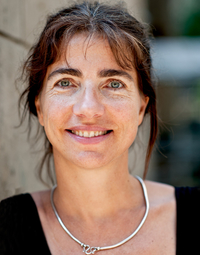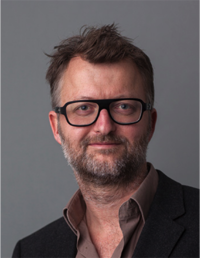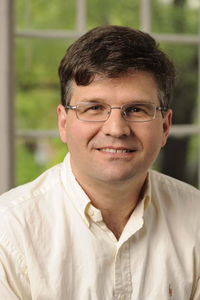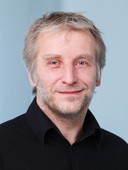Keynote talks
Yeast Mating in Space and Time
Edda Klipp
Humboldt-Universität zu Berlin, Germany
Baker’s yeast (Saccharomyces cerevisiae) has a diploid life-style, but under stress conditions it forms spores which then release haploid cells of mating types MATa and MATα. MATa cells are a frequently used model organism for many cell biological studies of cell cycle, metabolism or signaling. MATa and MATα cells can also mate to form diploid cells again. To this end they secrete the pheromones a-factor and α-factor, sense the opposite pheromone and form protrusions in the direction of a potential mating partner. Importantly, they cannot move towards their mating partner, thus the formation of the mating shape called shmoo is a significant investment. Combining experimental studies of the cellular responses to mating factor and the resulting shape changes with spatial mathematical modeling, we investigated three major steps in the mating process. Specifically, we asked (i) how yeast cells communicate to form sharp gradients allowing precise decisions, (ii) how the individual cells sense the resulting gradients and (iii) how they translate the sensed information into shape changes.
| Edda Klipp is full professor for Theoretical Biophysics at Humboldt-Universität zu Berlin since 2008. She has a doctoral degree in theoretical biophysics and held a position as research scientist at Humboldt-Universität following a postdoctoral period in Berlin. From 2001 to 2006, she was junior research group leader in “Kinetic modeling” before taking over the head of the research group “Computational Systems Biology” at Max-Planck Institute for Molecular Genetics until 2008. In 2009 she was awarded an honorary doctor of Göteborg University. 2015 she was awarded the Caroline-von-Humboldt professorship at Humboldt-Universität zu Berlin. Prof. Klipp is a founding member of the International Society of Systems Biology, member of several scientific advisory boards for systems biology consortia and institutions and she is principal investigator in several European and national research consortia for systems biology. She organizes a graduate program in Computational Systems Biology in Berlin. |  |
Regulation of metabolism: navigating between desired and fatal states
Bas Teusink
Vrije Universiteit Amsterdam
Cells evolved a remarkable ability to adapt to environmental conditions, or to withstand otherwise detrimental mutations. These properties arise from the integrative functioning of biological networks. Functional genomics has allowed the cost-effective measurement of the network components; however, we still mostly fail to understand how their interactions lead to cellular function and adaptation. One view that is becoming dominant in cellular physiology, is that physical and (bio)chemical constraints limits protein content and synthesis, impacting how resources are partitioned over growth and stress processes to optimize fitness (“cellular economics”). This view contrasts current mainstream modeling efforts at the genome-scale, which are largely focussed on the metabolic network only, and subsequently they often fail to predict the proper regulation of fluxes. I will show with some practical examples, however, when and how these models are still useful, and how we can integrate the cellular economy into these models. Still, the resource allocation perspective is developed for steady-state growth under constant environments, and mostly for E. coli. Whether this perspective is relevant for other microorganisms remains unclear. Moreover, what happens during transitions between steady-state growth conditions is largely unexplored. Recent studies in yeast show that the response time after a nutrient change is an evolvable trait that is dependent on nutrient dynamics and comes at the cost of balanced growth rate. We showed that an intricate and dynamic regulatory mechanism is in place in yeast to ensure robustness during glucose transitions. Thus, the aim of this talk is to illustrate how regulation of metabolism is an intruiging balancing act between desired and fatal states, shaped by constraints and trade-offs.
|
Prof. dr. Bas Teusink studied (Bio)Chemistry at the University of Amsterdam and performed his PhD research in the field of theoretical biochemistry at the same university. During his PhD research, he studied the dynamics of glycolysis in yeast; he then switched to biomedical research in Leiden, where he studied lipid and glucose metabolism in mouse models. In 2008, Teusink became professor of Systems Biology and Integrative Bioinformatics at VU University Amsterdam. The focus is more in general on the use of constraint-optimization techniques to investigate the design principles of cellular physiology. The main organisms in the Teusink lab are currently Lactoccocus lactis, Escherichia coli and Saccharomyces cerevisiae. Although much of Teusink’s work is fundamental in nature (he is a 2015 recipient of a prestigous Dutch VICI grant for scientific excellence), it is recognized by industry, as is evident from several public-private partnerships and the midterm carreer award he received in 2014 from the LABIP, the Lactic Acid Bacteria Industrial Platform. |
 |
The regulation of cell motility through an excitable system
Pablo A. Iglesias
Johns Hopkins University
Recent years have demonstrated that the actin cytoskeleton and other signaling elements in motile cells have many of the hallmarks of an excitable medium, including the presence of propagating waves, a refractory period, as well as a threshold for activation. In this talk I show how these behaviors can be explained by the presence of a signal transduction excitable network that integrates a number of signals and coordinates actin polymerization. In this model, spontaneous triggering of the excitable network accounts for the random migration of unstimulated cells. Moreover, internal and external signals – both chemical and mechanical – bias excitability spatially, thus providing a means by which cell motility is directed towards spatial cues. We also show how the model predicts that the set point of the excitable system can be altered by changing the threshold. Moreover, these perturbations give rise to different migratory modes, including amoeboid, keratocyte-like and oscillatory movement. We demonstrate that our theoretical predictions can be recreated experimentally in motile amoeba.
| Pablo A. Iglesias was born in Caracas, Venezuela. He received the B.A.Sc. degree in Engineering Science from the University of Toronto in 1987, and the Ph.D. degree in Control Engineering from Cambridge University in 1991. Since then he has been on the faculty of the Johns Hopkins University, where he is currently the Edward J. Schaefer Professor of Electrical Engineering. He also holds appointments in the Departments of Biomedical Engineering, and Applied Mathematics & Statistics as well as the Department of Cell Biology in the Johns Hopkins School of Medicine. He has had visiting appointments at Lund University (Automatic Control), The Weizmann Institute of Science (Mathematics), the California Institute of Technology (Control and Dynamical Systems), and the Max-Planck Institute for the Physics of Complex Systems in Dresden, Germany. |  |
Identification of Predictive Dynamic Models for Systems Biology
Jörg Stelling
ETH Zürich
Limited mechanistic knowledge, conflicting hypotheses, and still relatively scarce experimental data hamper the development of dynamic models for cellular networks. In addition, systems identification is often challenging because it concerns network topologies and parameters simultaneously. This talk will address open problems and new methods for systems identification at different levels of granularity, ideally leading to detailed mechanistic systems models. To derive a coarse-grained representation of network topologies, for example, to identify unknown natural inputs to signaling pathways, we discuss a probabilistic inference approach that relies on prototypic ‘network
motifs’ and its application to nutrient signaling in yeast. When a basic model structure is inferred, but many mechanistic hypotheses are to be evaluated, the method of ‘topological filtering’ enables one to automatically generate a set of simple(r) models compatible with observational data; this approach allowed us to identify a single,
highly plausible circuit topology in a stress signaling circuit by experiment-theory iterations. Finally, we will emphasize how network modularization and advanced numerical methods may achieve scalability of such identification approaches, which is critical for many real-world applications.
| Jörg Stelling is a Professor for Computational Systems Biology at ETH Zurich. He studied Biotechnology at the Technical University of Braunschweig, before moving to the newly founded Max-Planck Institute for Dynamics of Complex Technical Systems, Magdeburg. He received his PhD in 2004 in systems dynamics and control from the Department of Mechanical Engineering, University of Stuttgart; his PhD thesis devised new methods for the analysis of robustness in complex biological networks. In 2005, he joined ETH Zurich’s Computer Science Department before moving to the new ETH Department of Biosystems Science and Engineering in 2008. His current research interests are focused on the analysis and synthesis of biological networks using - and further developing - methods from systems theory and computer science. The highly interdisciplinary character of the research projects is reflected by an (international)network of collaborators from different disciplines. |  |
